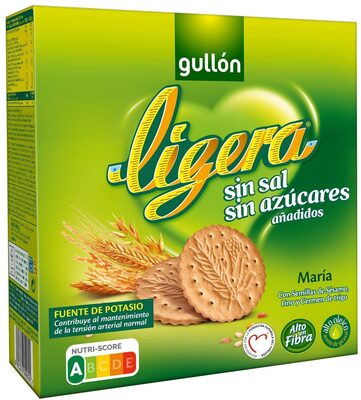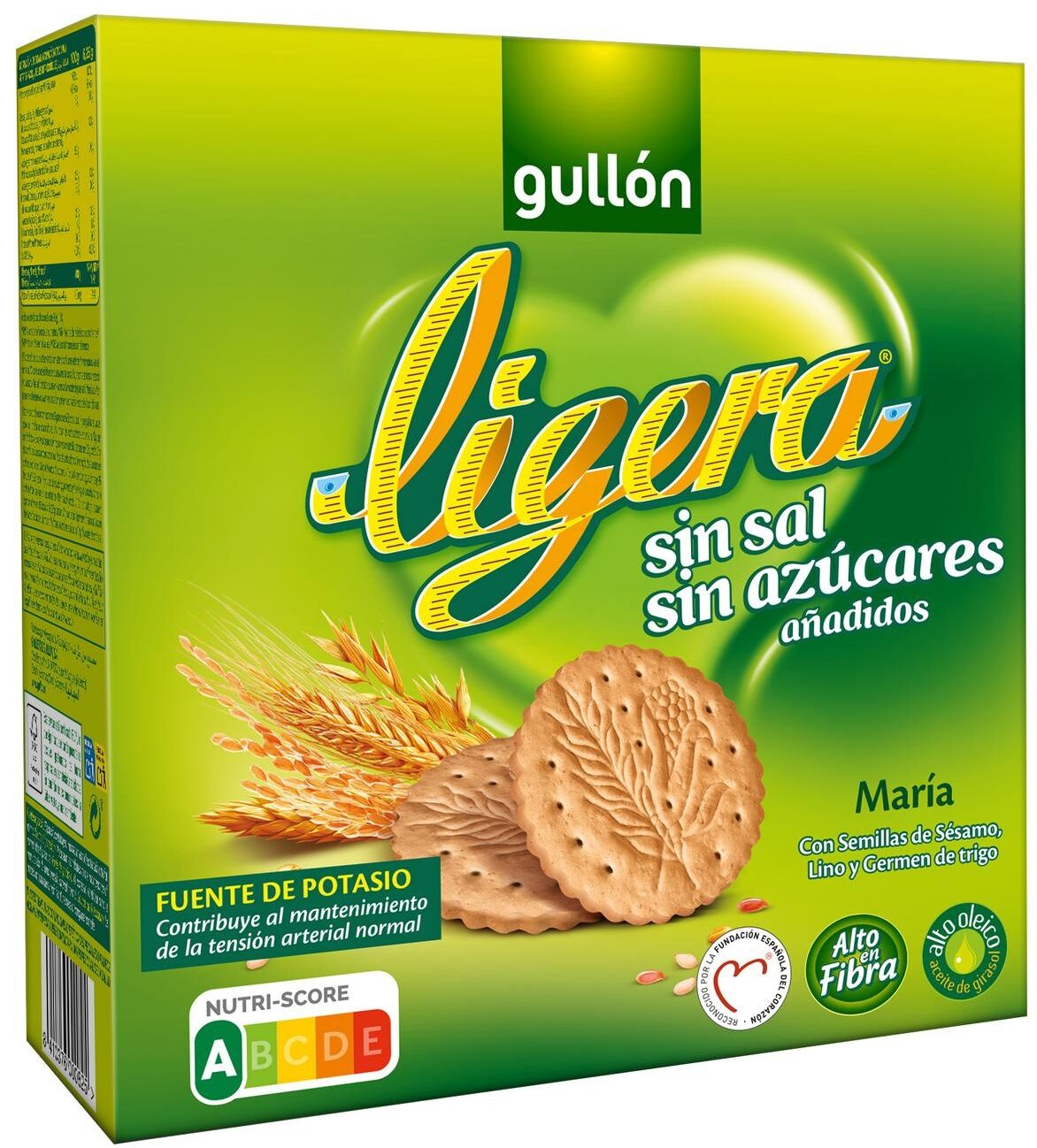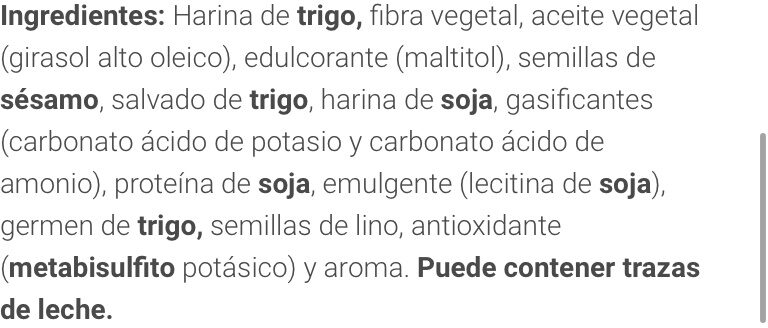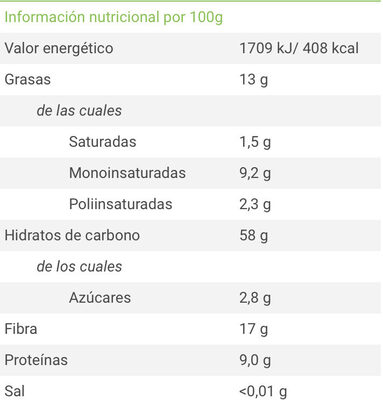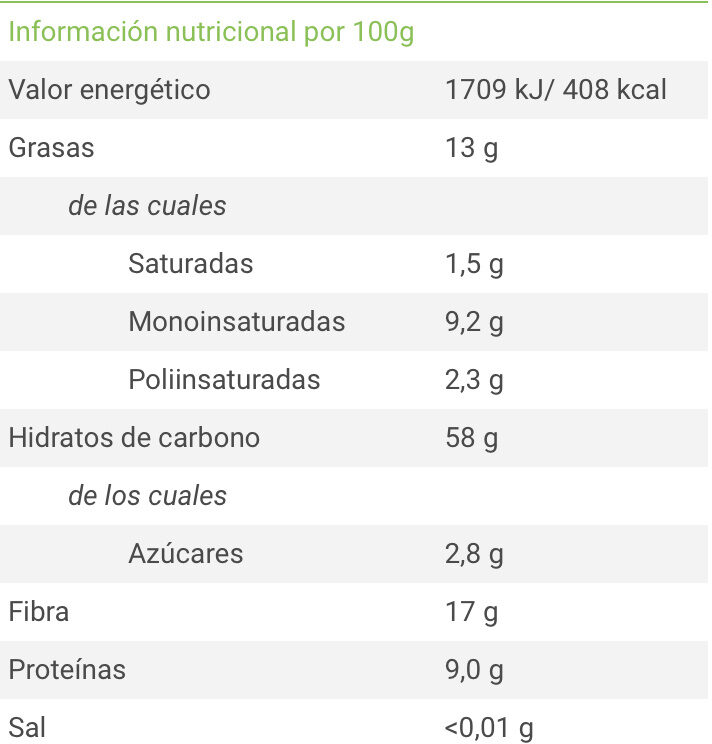Ajuda'ns a fer que la transparència alimentària sigui la norma!
Com a organització sense ànim de lucre, depenem de les vostres donacions per continuar informant els consumidors de tot el món sobre tot allò què mengen.
La revolució alimentària comença amb tu!
Galleta maría ligera sin sal y sin azúcar - Gullón - 600 g (3 x 200 g)
Galleta maría ligera sin sal y sin azúcar - Gullón - 600 g (3 x 200 g)
Aquesta pàgina del producte no està completa. Podeu ajudar a completar-la editant-la i afegint-hi més dades a partir de les fotos ja disponibles, o fent-ne més amb l'aplicació de androide o iPhone / iPad. Gràcies!
×
Codi de barres: 8410376000825 (EAN / EAN-13)
Nom comú: Galleta con cereales sin azúcares añadidos con edulcorante y sin sal
Quantitat: 600 g (3 x 200 g)
Empaquetament: Plàstic, en:Box, en:container
Marques: Gullón
Categories: Snacks, Aperitius dolços, Galetes i pastissos, Galetes, es:Galletas maría
Etiquetes, certificacions, premis:
Baix o sense sal, Sense o baix en sucre, Source of fibre, Punt verd, Alt en fibra, Sense sucre afegit, Sense sal, Comptador Nutricional, Grau A Nutriscore, Amb edulcorants, es:Con aceite de girasol alto oleico, es:Fuente de potasio
Llocs de fabricació o processament: España
Enllaç a la pàgina del producte en el lloc oficial del productor: http://www.gullon.es/es/MariaLigera
Botigues: Alcampo, Eroski, Condis, Hipercor, El Corte Inglés, Carrefour, Dia, Caprabo, Consum, Súper Vera
Matching with your preferences
Salut
Ingredients
-
20 ingredients
Castellà: Harina de trigo 51,5%, fibra vegetal, aceite vegetal (girasol alto oleico) 9%, edulcorante (maltitol), semillas de sésamo 4,5%, salvado de trigo, harina de soja, gasificantes (carbonato ácido de potasio, carbonato ácido de amonio), proteína de soja, emulgente (lecitina de soja), germen de trigo 0,2%, semillas de lino 0,2%, antioxidante (metabisulfito potásico), aroma de vainilla.Al·lèrgens: en:Gluten, en:Sesame seeds, en:Soybeans, es:metabisulfito, es:metabisulfitoRastres: en:Milk
Processament d'aliments
-
Aliments ultra processats
Elements que indiquen que el producte està al grup 4 - Aliments i begudes ultraprocessats:
- Additiu: E322 - Lecitines
- Additiu: E965 - Maltitol
- Ingredient: Emulsionant
- Ingredient: Aromes
- Ingredient: Edulcorant
Els productes alimentaris es classifiquen en 4 grups segons el seu grau de processament:
- Aliments no processats o mínimament processats
- Ingredients culinaris processats
- Aliments processats
- Aliments ultra processats
La determinació del grup es fa en funció de la categoria del producte i dels ingredients que conté.
Additius
-
E224 - Metabisulfit de potassi
Potassium metabisulfite: Potassium metabisulfite, K2S2O5, also known as potassium pyrosulfite, is a white crystalline powder with a pungent sulfur odour. The main use for the chemical is as an antioxidant or chemical sterilant. It is a disulfite and is chemically very similar to sodium metabisulfite, with which it is sometimes used interchangeably. Potassium metabisulfite is generally preferred out of the two as it does not contribute sodium to the diet. Potassium metabisulfite has a monoclinic crystal structure which decomposes at 190 °C, yielding potassium sulfite and sulfur dioxide: K2S2O5-s- → K2SO3-s- + SO2-g-Origen: Wikipedia (Anglès)
-
E322 - Lecitines
Lecithin: Lecithin -UK: , US: , from the Greek lekithos, "egg yolk"- is a generic term to designate any group of yellow-brownish fatty substances occurring in animal and plant tissues, which are amphiphilic – they attract both water and fatty substances -and so are both hydrophilic and lipophilic-, and are used for smoothing food textures, dissolving powders -emulsifying-, homogenizing liquid mixtures, and repelling sticking materials.Lecithins are mixtures of glycerophospholipids including phosphatidylcholine, phosphatidylethanolamine, phosphatidylinositol, phosphatidylserine, and phosphatidic acid.Lecithin was first isolated in 1845 by the French chemist and pharmacist Theodore Gobley. In 1850, he named the phosphatidylcholine lécithine. Gobley originally isolated lecithin from egg yolk—λέκιθος lekithos is "egg yolk" in Ancient Greek—and established the complete chemical formula of phosphatidylcholine in 1874; in between, he had demonstrated the presence of lecithin in a variety of biological matters, including venous blood, in human lungs, bile, human brain tissue, fish eggs, fish roe, and chicken and sheep brain. Lecithin can easily be extracted chemically using solvents such as hexane, ethanol, acetone, petroleum ether, benzene, etc., or extraction can be done mechanically. It is usually available from sources such as soybeans, eggs, milk, marine sources, rapeseed, cottonseed, and sunflower. It has low solubility in water, but is an excellent emulsifier. In aqueous solution, its phospholipids can form either liposomes, bilayer sheets, micelles, or lamellar structures, depending on hydration and temperature. This results in a type of surfactant that usually is classified as amphipathic. Lecithin is sold as a food additive and dietary supplement. In cooking, it is sometimes used as an emulsifier and to prevent sticking, for example in nonstick cooking spray.Origen: Wikipedia (Anglès)
-
E322i - Lecitina
Lecithin: Lecithin -UK: , US: , from the Greek lekithos, "egg yolk"- is a generic term to designate any group of yellow-brownish fatty substances occurring in animal and plant tissues, which are amphiphilic – they attract both water and fatty substances -and so are both hydrophilic and lipophilic-, and are used for smoothing food textures, dissolving powders -emulsifying-, homogenizing liquid mixtures, and repelling sticking materials.Lecithins are mixtures of glycerophospholipids including phosphatidylcholine, phosphatidylethanolamine, phosphatidylinositol, phosphatidylserine, and phosphatidic acid.Lecithin was first isolated in 1845 by the French chemist and pharmacist Theodore Gobley. In 1850, he named the phosphatidylcholine lécithine. Gobley originally isolated lecithin from egg yolk—λέκιθος lekithos is "egg yolk" in Ancient Greek—and established the complete chemical formula of phosphatidylcholine in 1874; in between, he had demonstrated the presence of lecithin in a variety of biological matters, including venous blood, in human lungs, bile, human brain tissue, fish eggs, fish roe, and chicken and sheep brain. Lecithin can easily be extracted chemically using solvents such as hexane, ethanol, acetone, petroleum ether, benzene, etc., or extraction can be done mechanically. It is usually available from sources such as soybeans, eggs, milk, marine sources, rapeseed, cottonseed, and sunflower. It has low solubility in water, but is an excellent emulsifier. In aqueous solution, its phospholipids can form either liposomes, bilayer sheets, micelles, or lamellar structures, depending on hydration and temperature. This results in a type of surfactant that usually is classified as amphipathic. Lecithin is sold as a food additive and dietary supplement. In cooking, it is sometimes used as an emulsifier and to prevent sticking, for example in nonstick cooking spray.Origen: Wikipedia (Anglès)
-
E501 - Carbonats de potassi
Potassium carbonate: Potassium carbonate -K2CO3- is a white salt, which is soluble in water -insoluble in ethanol- and forms a strongly alkaline solution. It can be made as the product of potassium hydroxide's absorbent reaction with carbon dioxide. It is deliquescent, often appearing a damp or wet solid. Potassium carbonate is used in the production of soap and glass.Origen: Wikipedia (Anglès)
-
E501ii
Potassium carbonate: Potassium carbonate -K2CO3- is a white salt, which is soluble in water -insoluble in ethanol- and forms a strongly alkaline solution. It can be made as the product of potassium hydroxide's absorbent reaction with carbon dioxide. It is deliquescent, often appearing a damp or wet solid. Potassium carbonate is used in the production of soap and glass.Origen: Wikipedia (Anglès)
-
E503 - Carbonatos de amonio
Ammonium carbonate: Ammonium carbonate is a salt with the chemical formula -NH4-2CO3. Since it readily degrades to gaseous ammonia and carbon dioxide upon heating, it is used as a leavening agent and also as smelling salt. It is also known as baker's ammonia and was a predecessor to the more modern leavening agents baking soda and baking powder. It is a component of what was formerly known as sal volatile and salt of hartshorn.Origen: Wikipedia (Anglès)
-
E503ii - Carbonat àcid d'amoni
Ammonium carbonate: Ammonium carbonate is a salt with the chemical formula -NH4-2CO3. Since it readily degrades to gaseous ammonia and carbon dioxide upon heating, it is used as a leavening agent and also as smelling salt. It is also known as baker's ammonia and was a predecessor to the more modern leavening agents baking soda and baking powder. It is a component of what was formerly known as sal volatile and salt of hartshorn.Origen: Wikipedia (Anglès)
-
E965 - Maltitol
Maltitol: Maltitol is a sugar alcohol -a polyol- used as a sugar substitute. It has 75–90% of the sweetness of sucrose -table sugar- and nearly identical properties, except for browning. It is used to replace table sugar because it is half as caloric, does not promote tooth decay, and has a somewhat lesser effect on blood glucose. In chemical terms, maltitol is known as 4-O-α-glucopyranosyl-D-sorbitol. It is used in commercial products under trade names such as Lesys, Maltisweet and SweetPearl.Origen: Wikipedia (Anglès)
Anàlisi dels ingredients
-
No conté oli de palma
No s'han detectat ingredients que continguin oli de palma
-
Pot ser vegà
Ingredients que potser no són vegans: Aroma de vainilla
-
Pot ser vegetarià
Ingredients que potser no són vegetarians: Aroma de vainilla
-
Detalls de l'anàlisi dels ingredients
es: Harina de _trigo_ 51.5%, fibra vegetal, aceite vegetal 9% (girasol alto oleico), edulcorante (maltitol), semillas de _sésamo_ 4.5%, salvado de _trigo_, harina de _soja_, gasificantes (carbonato ácido de potasio, carbonato ácido de amonio), proteína de _soja_, emulgente (lecitina de _soja_), germen de _trigo_ 0.2%, semillas de lino 0.2%, antioxidante (_metabisulfito_ potásico), aroma de vainilla- Harina de _trigo_ -> en:wheat-flour - vegan: yes - vegetarian: yes - ciqual_proxy_food_code: 9410 - percent_min: 51.5 - percent: 51.5 - percent_max: 51.5
- fibra vegetal -> en:vegetable-fiber - vegan: yes - vegetarian: yes - percent_min: 9 - percent_max: 29.1
- aceite vegetal -> en:vegetable-oil - vegan: yes - vegetarian: yes - from_palm_oil: maybe - percent_min: 9 - percent: 9 - percent_max: 9
- girasol alto oleico -> en:high-oleic-sunflower - vegan: yes - vegetarian: yes - from_palm_oil: no - ciqual_food_code: 17440 - percent_min: 9 - percent_max: 9
- edulcorante -> en:sweetener - percent_min: 4.5 - percent_max: 9
- maltitol -> en:e965 - vegan: yes - vegetarian: yes - percent_min: 4.5 - percent_max: 9
- semillas de _sésamo_ -> en:sesame-seeds - vegan: yes - vegetarian: yes - ciqual_food_code: 15010 - percent_min: 4.5 - percent: 4.5 - percent_max: 4.5
- salvado de _trigo_ -> en:wheat-bran - vegan: yes - vegetarian: yes - ciqual_food_code: 9621 - percent_min: 0.2 - percent_max: 4.5
- harina de _soja_ -> en:soya-flour - vegan: yes - vegetarian: yes - ciqual_food_code: 20900 - percent_min: 0.2 - percent_max: 4.5
- gasificantes -> en:raising-agent - percent_min: 0.2 - percent_max: 4.5
- carbonato ácido de potasio -> en:e501ii - vegan: yes - vegetarian: yes - percent_min: 0 - percent_max: 4.5
- carbonato ácido de amonio -> en:e503ii - vegan: yes - vegetarian: yes - percent_min: 0 - percent_max: 2.25
- proteína de _soja_ -> en:soy-protein - vegan: yes - vegetarian: yes - ciqual_food_code: 20591 - percent_min: 0.2 - percent_max: 4.27142857142857
- emulgente -> en:emulsifier - percent_min: 0.2 - percent_max: 3.7125
- lecitina de _soja_ -> en:soya-lecithin - vegan: yes - vegetarian: yes - ciqual_food_code: 42200 - percent_min: 0.2 - percent_max: 3.7125
- germen de _trigo_ -> en:wheat-germ - vegan: yes - vegetarian: yes - ciqual_food_code: 9660 - percent_min: 0.2 - percent: 0.2 - percent_max: 0.2
- semillas de lino -> en:flax-seed - vegan: yes - vegetarian: yes - ciqual_food_code: 15034 - percent_min: 0.2 - percent: 0.2 - percent_max: 0.2
- antioxidante -> en:antioxidant - percent_min: 0 - percent_max: 0.2
- _metabisulfito_ potásico -> en:e224 - vegan: yes - vegetarian: yes - percent_min: 0 - percent_max: 0.2
- aroma de vainilla -> en:vanilla-flavouring - vegan: maybe - vegetarian: maybe - percent_min: 0 - percent_max: 0.2
Nutrició
-
Molt bona qualitat nutricional
⚠ ️Atenció: la quantitat de fruita, verdura i fruits secs no s'especifica a l'etiqueta, s'ha fet una estimació a partir de la llista d'ingredients: 0Aquest producte no es considera una beguda per al càlcul de la Nutri-Score.
Punts positius: 10
- Proteïnes: 5 / 5 (valor: 9, valor arrodonit: 9)
- Fibra: 5 / 5 (valor: 17, valor arrodonit: 17)
- Fruites, verdures, fruits secs i olis de colza/nou/oliva: 0 / 5 (valor: 0, valor arrodonit: 0)
Punts negatius: 6
- Energia: 5 / 10 (valor: 1707, valor arrodonit: 1707)
- Sucres: 0 / 10 (valor: 2.8, valor arrodonit: 2.8)
- Greixos saturats: 1 / 10 (valor: 1.5, valor arrodonit: 1.5)
- Sodi: 0 / 10 (valor: 0, valor arrodonit: 0)
Els punts per proteïnes es compten perquè els punts negatius són inferiors a 11.
Puntuació nutricional: (6 - 10)
Nutri-Score:
-
Nivells de nutrients
-
Greix en Quantitat moderada (13%)
Què us cal saber- Un alt consum de greixos, especialment de greixos saturats, pot augmentar el colesterol, que augmenta el risc de patir malalties del cor.
Recomanació: Reduïu el consum de greixos i greixos saturats- Trieu productes amb menys greixos i greixos saturats.
-
Àcid gras saturat en Quantitat moderada (1.5%)
Què us cal saber- Un alt consum de greixos, especialment de greixos saturats, pot augmentar el colesterol, que augmenta el risc de patir malalties del cor.
Recomanació: Reduïu el consum de greixos i greixos saturats- Trieu productes amb menys greixos i greixos saturats.
-
Sucre en baixa quantitat (2.8%)
Què us cal saber- Un alt consum de sucre pot provocar augment de pes i càries dental. També augmenta el risc de patir diabetis tipus 2 i malalties cardiovasculars.
Recomanació: Limitau el consum de sucre i de begudes ensucrades- Les begudes ensucrades (com ara refrescos, begudes de fruites i sucs i nèctars de fruites) s'han de limitar tant com sigui possible (no més d'1 got al dia).
- Triau productes amb menor contingut de sucre i reduïu el consum de productes amb sucres afegits.
-
Sal comuna en baixa quantitat (0%)
Què us cal saber- Un alt consum de sal (o sodi) pot provocar un augment de la pressió arterial, que pot augmentar el risc de patir malalties del cor i ictus.
- Moltes persones que tenen hipertensió no ho saben, ja que sovint no en tenen símptomes.
- La majoria de la gent consumeix massa sal (de 9 a 12 grams de mitjana al dia), al voltant del doble del nivell màxim d'ingesta recomanat.
Recomanació: Limitau la ingesta de sal i d'aliments rics en sal- Reduïu la sal que emprau quan cuinau, i no afegiu sal a taula.
- Limiteu el consum d'aperitius salats i trieu productes amb menor contingut de sal.
-
-
Informació nutricional
Informació nutricional Com es ven
per 100 g/100 mlCom es ven
per porció (6.25 g)Comparat amb: es:Galletas maría Energia 1.707 kj
(408 kcal)107 kj
(25 kcal)-8% Greix 13 g 0,812 g +2% Àcid gras saturat 1,5 g 0,094 g -46% Àcid gras monoinsaturat 9,2 g 0,575 g Àcid gras poliinsaturat 2,3 g 0,144 g Hidrats de carboni 58 g 3,62 g -21% Sucre 2,8 g 0,175 g -85% Fiber 17 g 1,06 g +389% Proteïna 9 g 0,562 g +28% Sal comuna 0 g 0 g -100% Potassi 480 mg 30 mg Fruits‚ vegetables‚ nuts and rapeseed‚ walnut and olive oils (estimate from ingredients list analysis) 0 % 0 %
Entorn
-
Eco-puntuació C - Impacte ambiental moderat
El Eco-Score és una puntuació experimental que resumeix els impactes ambientals dels productes alimentaris.→ L'Eco-Score es va desenvolupar inicialment a França i s'està ampliant per a altres països europeus. La fórmula Eco-Score està subjecta a canvis, ja que es millora periòdicament per fer-la més precisa i més adequada per a cada país.Anàlisi del cicle de vida
-
Impacte mitjà dels productes de la mateixa categoria: B (Score: 69/100)
Categoria: Biscuit (cookie)
Categoria: Biscuit (cookie)
- Puntuació ambiental PEF ( petjada ambiental de l'aliment ): 0.35 (com més baixa sigui la puntuació, menor serà l'impacte)
- incloent l'impacte sobre el canvi climàtic: 2.88 kg CO₂ eq/kg del producte
Etapa Impacte Agricultura
80.5 %Processament
11.8 %Empaquetament
3.1 %Transport
3.2 %Distribució
1.4 %Consum
0.0 %
Bonificacions i punts negatius
-
Falta informació sobre l'origen dels ingredients
Punts negatius: -5
⚠ ️ L'origen dels ingredients d'aquest producte no està indicat.
Si estan indicats a l'embalatge, podeu modificar la fitxa del producte i afegir-los.
Si sou el fabricant d'aquest producte, podeu enviar-nos la informació amb la nostra plataforma gratuïta per a productors.
-
Embalatge d'alt impacte
Punts negatius: -15
Forma Material Reciclatge Impacte container Plàstic Alt Box Unknown Alt ⚠ ️ La informació sobre l'embalatge d'aquest producte no és prou precisa (formes i materials exactes de tots els components de l'embalatge).⚠ ️ Per a un càlcul més precís de l'Eco-Score, podeu modificar la pàgina del producte i afegir-los.
Si sou el fabricant d'aquest producte, podeu enviar-nos la informació amb la nostra plataforma gratuïta per a productors.
Eco-Score per a aquest producte
-
Impacte per a aquest producte: C (Score: 49/100)
Producte: Galleta maría ligera sin sal y sin azúcar - Gullón - 600 g (3 x 200 g)
Puntuació de l'anàlisi del cicle de vida: 69
Suma de bonificacions i punts negatius: -20
Puntuació final: 49/100
-
Petjada de carboni
-
Equivalent a conduir 1.5 km en un cotxe de gasolina
288 g de CO² per cada 100 g de producte
La xifra d'emissions de carboni prové de la base de dades Agribalyse d'ADEME, per a la categoria: Biscuit (cookie) (Font: Base de dades ADEME Agribalyse)
Etapa Impacte Agricultura
82.9 %Processament
7.9 %Empaquetament
3.8 %Transport
4.7 %Distribució
0.7 %Consum
0.0 %
Empaquetament
-
Embalatge d'alt impacte
-
Peces d'embalatge
container (Plàstic)
Box
-
Materials d'embalatge
Material % Pes de l'embalatge Pes de l'embalatge per 100 g de producte Plàstic
-
Transport
-
Orígens dels ingredients
Falta informació sobre l'origen dels ingredients
⚠ ️ L'origen dels ingredients d'aquest producte no està indicat.
Si estan indicats a l'embalatge, podeu modificar la fitxa del producte i afegir-los.
Si sou el fabricant d'aquest producte, podeu enviar-nos la informació amb la nostra plataforma gratuïta per a productors.Add the origins of ingredients for this product Add the origins of ingredients for this product
Report a problem
-
Incomplete or incorrect information?
Category, labels, ingredients, allergens, nutritional information, photos etc.
If the information does not match the information on the packaging, please complete or correct it. Open Food Facts is a collaborative database, and every contribution is useful for all.
Fonts de dades
Producte afegit per openfoodfacts-contributors
Última modificació de la pàgina del producte per ankedanay.
La pàgina del producte, també editada per beniben, elfarto, foodvisor, holaa33, kiliweb, maylord, musarana, neptuno, off.99c0f53f-3780-414e-9e8a-bad6142e56d7, packbot, roboto-app, scanbot, thaialagata, yuka.U3E0OE80OWYvZmdieGMwc3dnL295STF0K3BPbVp6eWFjOVVOSVE9PQ, yuka.VkxJYkZQMWRqYWNodzlvNCt6K08xZXQ2d2FYNFpVZTNJT3c3SVE9PQ, yuka.YUl4ZE9aOEVxdnN4dXRzazFVamMydTF1NW9IelEweTdNUFVCSWc9PQ.
